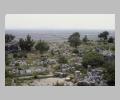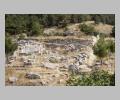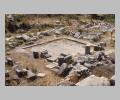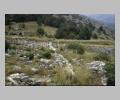| Context: | Priene |
| Type: | Prytaneion |
| Summary: | Meeting house and dining room for senate members, adjacent to bouleuterion, in center of city. |
| Date: | ca. 180 BC - ca. 150 AD |
| Dimensions: | Length of exterior north wall: ca. 17.50 m. Length of exterior west wall: ca. 24 m. Depth of three rooms at north: 5.05 m. Dimensions of square central courtyard ca. 7 m. Base diameter of courtyard columns 0.51 m. |
| Region: | Ionia |
| Period: | Hellenistic/Roman |
Architectural Order:
Unfluted columns supported the roof; a fragment of an Ionic capital was found, but it is too small to belong.
Plan:
The building in its present state takes the form of a peristyle house: a rectangular structure with central paved, colonnaded courtyard surrounded by three small rooms on the north, two on the west and three on the south sides. The building was entered through a door in the north wall of the central room in the south row.
Date Description:
There is little or no secure evidence for the initial construction date of the prytaneion. Its dating is based on its relationship to adjacent buildings, namely the bouleuterion (or ekklesiasterion) at Priene and the Sacred Stoa. The bouleuterion, which is adjacent to the prytaneion at the north-west, provides a terminus post quem for the construction of the prytaneion in its earliest phase. The prytaneion abuts against its east wall and the polished exterior east wall of the bouleuterion became the interior face of the west wall of the prytaneion. If the traditional dating of the bouleuterion to ca. 200 B.C. is adhered to (questioned by
History:
The preserved remains date to the Roman Imperial period, but an older building existed on the site. Elements which belong to the earlier, Greek building are the walls of the three rooms in the north, a stretch of east-west wall dividing the two rooms in the west, a short stretch of north-south wall in the south, and two very fragmentary walls in the east. It is uncertain whether the earlier structure had a central peristyle. A hearth in the south-east room is also identified as belonging to the Greek period.
Other Notes:
At the entrance to the southernmost room of the western row stands a reused column shaft carved with the following inscription: "The most brilliant city of the Ionian citizens of Priene and the most powerful Council and the most august Synhedrin of the elders in accordance with the things frequently received in (their?) accounts for...(council?) of the assemblies of the expenses of the city have honored M. Aur. Tatianus, the market official of the noble Pollion (?), the president of the festal assembly for the city's goddess Athena, the presiding officer of the goddess, the chief president, and the crowed president of the senate. May you prosper."
In the north-west corner of the central courtyard stands a marble base or table (height 0.68 m.) and a simple marble basin. In the easternmost room of the south row of rooms was a hearth. The presence of these features, the location of the building next to the bouleuterion, the proximity of the Sacred Stoa, and the presence of the dedicatory inscription contribute to the interpretation of the structure as a prytaneion; it has been argued, however, that there is no incontrovertible evidence that this structure is indeed the prytaneion of Priene: evidence for dining facilities is lacking, for example, and the plan contains many features of domestic architecture perhaps inappropriate for a civic building. If the present structure is indeed a prytaneion, and if its earliest construction date is accepted as the early second century B.C., there must have been an earlier prytaneion at Priene: inscriptions dating to the fourth century B.C. refer to a prytaneion, and it is most unlikely that the fourth century city would have lacked this important structure.
Other Bibliography:





